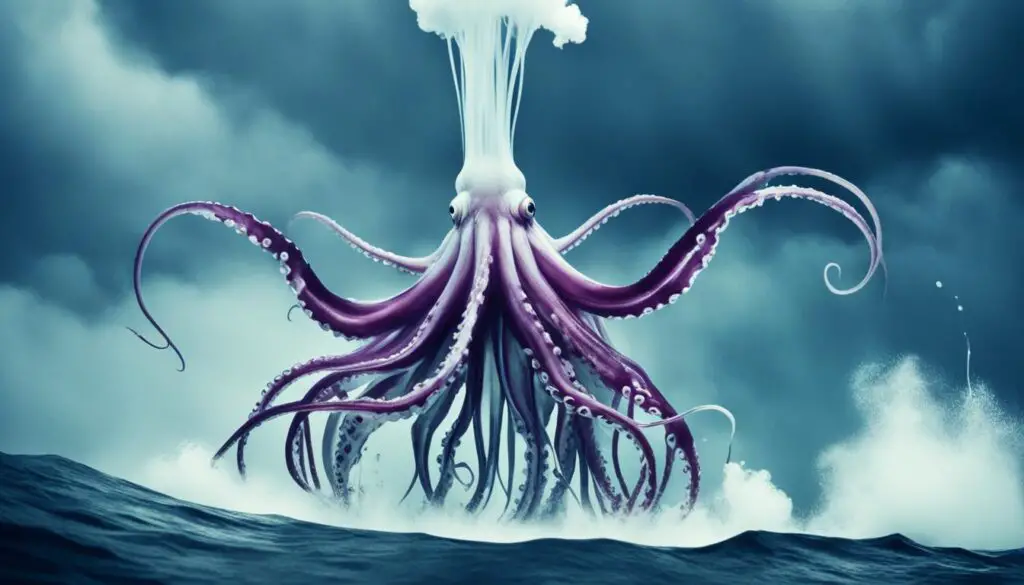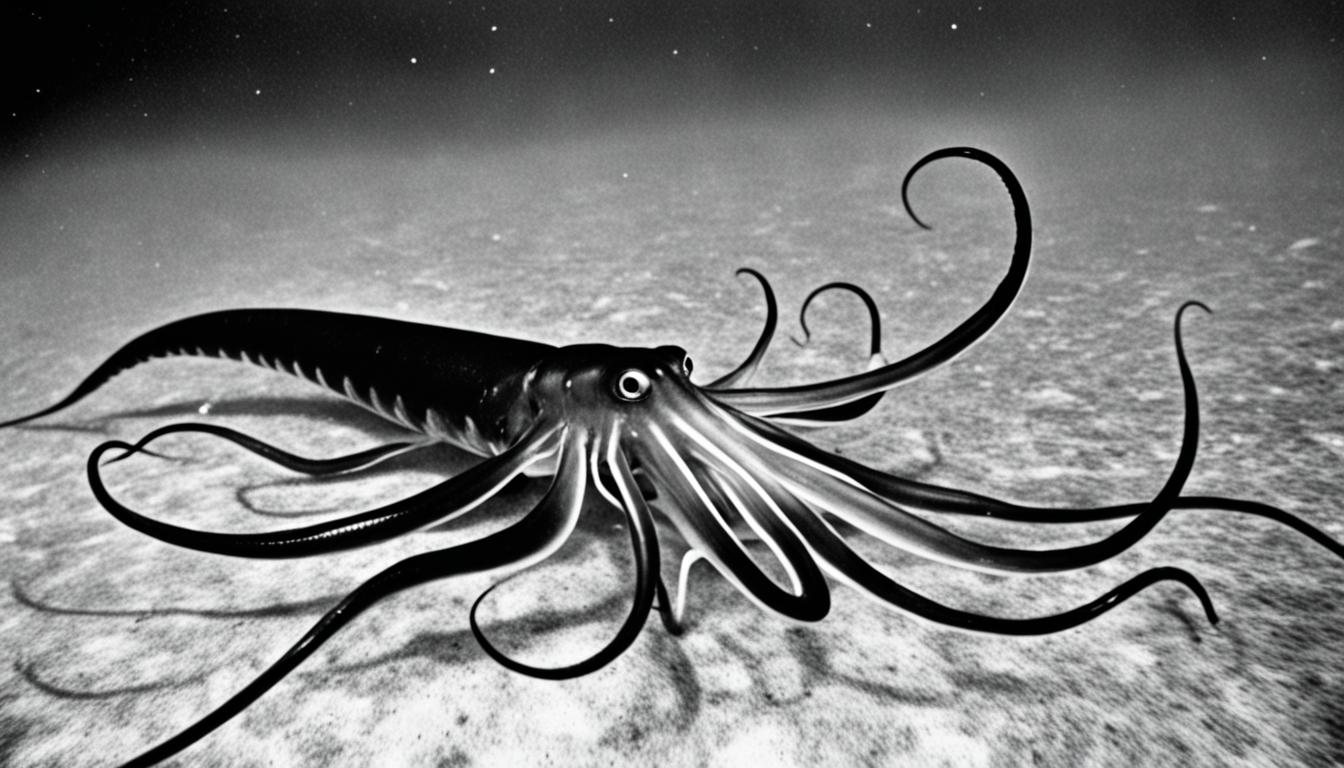Giant squids are mysterious and intriguing ocean creatures. They have clever ways to protect themselves. These strategies let them live in the deep sea and avoid predators.
They can blend into their surroundings and produce unique ink. This shows how smart giant squids are and their important role in the ocean.
Understanding Giant Squids: The Basics
Let’s dive into the world of giant squids and learn about their biology and unique traits. These amazing creatures are part of the cephalopod class. They are known for their smarts and how well they adapt to life in the water.
An Overview of the Giant Squid
The giant squid is a massive cephalopod, with some reaching lengths of up to 60 feet. They have big, expressive eyes and a strong beak. These features help them find their way and eat a wide variety of food. Learning about the giant squid helps us understand their importance in the ocean and the challenges they face.
Habitat and Distribution
Giant squids live in deep waters all over the world. They are found in the North Atlantic and South Pacific Oceans. They can survive in these deep areas, avoiding many predators and finding lots of food. By studying where they live, we can see how they interact with their environment.
| Characteristic | Details |
|---|---|
| Maximum Length | Up to 60 feet |
| Habitat | Deep offshore waters |
| Common Regions | North Atlantic, South Pacific |
| Distinct Features | Large eyes, powerful beak |
How do giant squids defend themselves?
Giant squids have amazing ways to protect themselves in the deep ocean. They use both their body and behavior to stay safe. This helps them survive in a world full of dangers.
Physical Adaptations for Defense
Their bodies are made for speed and agility in the water. They have long arms with suckers that help them catch food and avoid danger. If they feel threatened, they can cut off part of an arm to distract the attacker. This trick lets them get away safely.
They can also change color quickly to hide from predators. These features are key to their survival in the ocean.
Behavioral Defenses
Giant squids also use smart behaviors to stay safe. These include:
- Erratic movement patterns that confuse predators
- Playing dead in the presence of threats
- Fleeing at incredible speeds while releasing ink to obscure their escape
These behaviors help them survive and show how well they adapt to dangers. By using both body and mind, giant squids can overcome the challenges of deep-sea life.
| Adaptation Type | Description | Example |
|---|---|---|
| Physical Adaptation | Sleek, agile body for fast movement | Quickly evading predators |
| Physical Adaptation | Arms with suction cups for gripping | Capturing prey while escaping |
| Behavioral Defense | Erratic swimming patterns | Confusing predatory threats |
| Behavioral Defense | Releasing ink | Creating a smokescreen during escape |
The Role of Camouflage in Squid Defense
Giant squids use camouflage to survive in the deep ocean. They can change color and texture to hide from predators and sneak up on prey. This lets them adapt quickly to their surroundings. Let’s explore how giant squids blend into different aquatic environments.
Camouflaging Tactics
Giant squids have special skin called chromatophores that change color and texture fast. This helps them survive in the dark ocean. Here are some ways they camouflage:
- Color Change: They can match their skin color to their surroundings, blending in perfectly.
- Texture Alteration: They can also change their skin’s texture to look like rocks or other sea features.
- Shadow Manipulation: By controlling how light reflects off their skin, they can become less visible.
- Behavioral Adaptations: They can stay still or move slowly to help them blend in even more.
These tactics show how well giant squids have adapted to their environment. They are both skilled hunters and hard to catch. Learning about their camouflage helps us appreciate marine life and how creatures survive in the ocean.
| Camo Technique | Description | Advantages |
|---|---|---|
| Color Change | Altering skin color to blend with surroundings. | Increases ability to hide from predators. |
| Texture Change | Modifying skin texture to resemble different surfaces. | Enhances mimicry of environment. |
| Shadow Manipulation | Adjusting light reflection on skin. | Decreases visibility in bright conditions. |
| Behavioral Adaptation | Staying still or moving cautiously. | Reduces chances of detection. |
The Ink Defense Mechanism
The ink defense of giant squids is a key part of their survival plan. It shows how ink and their unique actions help them. By using ink well, giant squids can avoid predators and distract them, raising their survival odds.
How Ink Works
Giant squids make ink in a special organ called the ink sac. When they feel threatened, this sac releases a dark, thick fluid into the water. This fluid spreads out quickly, making a smokescreen that confuses predators.
The ink hides the squid and sometimes looks like other sea creatures. This makes predators focus on the fake shapes instead of the squid. This shows how giant squids can adapt and survive in danger.
Unique Ink Behavior
Giant squids release ink at the right time to escape danger. This distracts predators, helping the squid get away. They know how to use their surroundings and threats to their advantage.
Some squids change how much or thick the ink is, making it work better for each situation. This shows how smart giant squids are and how they’ve evolved over time.

| Ink Properties | Function | Behavioral Aspect |
|---|---|---|
| Color | Distracts predators | Immediate release when threatened |
| Density | Creates a smokescreen | Adjusts based on the situation |
| Shape | Fools predators | Can mimic other marine creatures |
Predators of the Giant Squid
The giant squid lives in a tough underwater world. The sperm whale is a top predator, known for its deep dives and hunting skills. These whales often leave marks on their bodies from fighting giant squids. This shows how intense their battles are.
Sharks and large fish are also threats to giant squids. The ocean’s vastness lets these predators sneak up and strike fast. Giant squids must be quick and clever to survive these dangers.
Giant squids fight back with amazing skills. They can move fast to get away from danger. Their ink can create a smoke screen, helping them escape unnoticed. This shows how adaptable and tough giant squids are in the deep sea.
Unique Survival Mechanisms of Giant Squids
Giant squids have amazing ways to survive in the deep sea. They have special traits that help them live in tough conditions. These traits show how well they can adapt to challenges in their world.
The Importance of Rapid Movement
Giant squids can move really fast, which is key to their survival. They use jet propulsion to zoom through the water. This helps them avoid predators and catch prey quickly.
Their body shape is also perfect for fast movement. It makes them agile and efficient as they move through the deep ocean.
Adaptations to Deep-Sea Life
Giant squids have special features for life in the deep sea. They have big eyes to see well in dim light, which helps them hunt. Their brains work fast to react to dangers quickly.
Their skin also has special properties that reflect light. This helps them blend in with the dark sea, avoiding predators.
| Adaptation | Description | Survival Benefit |
|---|---|---|
| Jet Propulsion | Rapid movement achieved by expelling water | Effective evasion of predators |
| Streamlined Body | Shape designed for efficient swimming | Enhances agility in the water |
| Large Eyes | Maximizes vision in darkness | Aids in locating prey and detecting danger |
| Advanced Nervous System | Quick processing of sensory information | Facilitates instant responses to threats |
| Light-Reflecting Skin | Adaptation for camouflage | Helps avoid detection by predators |
These special traits show how well giant squids can survive in the deep sea. Each one helps them stay alive despite the dangers in the ocean.
The Mystery and Future of Giant Squids
The giant squid has always fascinated us, wrapped in a mix of legend and science. Researchers are now exploring their biology and behavior, showing us how they live in the deep sea. Yet, there’s still so much we don’t know, highlighting the need for more research on these amazing creatures.
The future of giant squids is a big concern, especially with human actions harming the ocean. It’s crucial to protect deep-sea animals like giant squids to keep marine ecosystems balanced. We must fight against pollution, climate change, and overfishing to save our oceans.
Learning more about giant squids can make us appreciate their importance in the ocean. By understanding their future, we can help protect their homes and ensure they continue to exist. This will help keep our oceans diverse and healthy for the future.
FAQ
How do giant squids defend themselves against predators?
Giant squids use many ways to avoid predators. They are agile, release ink, and move erratically. They also hide by changing color and shape.
What physical adaptations do giant squids possess for defense?
They have agile bodies and strong beaks. Their arms have suction cups for catching prey and escaping. They can also cut off an arm to distract predators.
How does camouflage help giant squids survive in the ocean?
Camouflage helps them blend in. They change color and texture with chromatophores. This makes them hard to see and helps them hunt better.
What is the role of ink in giant squid defense?
Ink acts as a smokescreen to confuse predators. It lets the squid escape. The ink can also look like something else, distracting predators.
Who are the main predators of giant squids?
Sperm whales mainly eat giant squids. These whales often get scars from the squid’s suction cups during these hunts.
What unique survival mechanisms do giant squids have for deep-sea living?
They move fast using jet propulsion to avoid threats. They have a streamlined body and advanced nervous system. These help them live in the deep sea.
Why is understanding the future of giant squids important?
Knowing about giant squids is key for conservation. We need to protect their homes and help them survive against human harm to the oceans.







